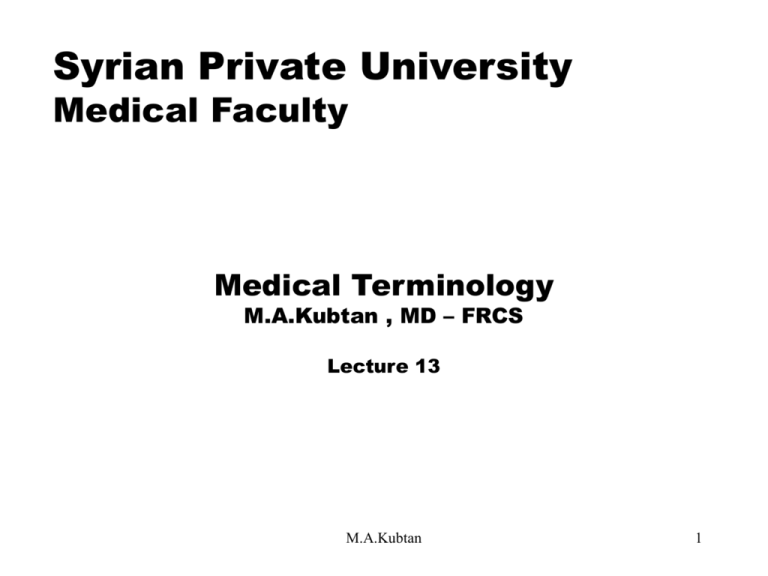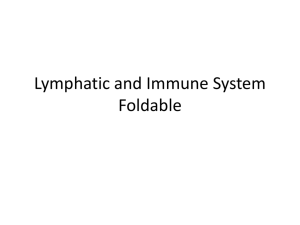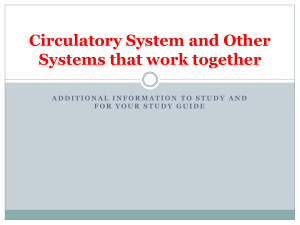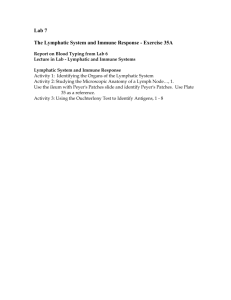The Lymphatic and Immune Systems
advertisement

Syrian Private University Medical Faculty Medical Terminology M.A.Kubtan , MD – FRCS Lecture 13 M.A.Kubtan 1 The Lymphatic & Immune Systems Thymus Spleen Lymph nodes Lymphatic vessel M.A.Kubtan 2 Objectives After studying this chapter, you will be able to: •Name the parts of the lymphatic and immune systems and discuss the function of each part •Define combining forms used in building words that relate to the lymphatic and immune system •Identify the meaning of related abbreviations •Name the common diagnoses, clinical procedures, and laboratory tests used in treating the lymphatic and immune systems M.A.Kubtan 3 Objectives Part 2 •List and define the major pathological conditions of the lymphatic and immune systems •List common pharmacological agents used in treating disorders of the lymphatic and immune systems. M.A.Kubtan 4 Lymphatic Organs and Structures The Lymphatic and Immune System Lymphatic Organs and Structures Lymph •A fluid containing: -water -sugars -white blood cells -protein -salts -waste Lymph Vessels •Carry lymph within the lymphatic system •Lymph capillaries are the smallest of the lymph vessels M.A.Kubtan 5 Capillaries Capillaries have thin walls which allow fluid in body tissues to flow between the capillaries and tissues. Fluid in the spaces between tissues is called interstitial fluid Once the interstitial fluid flows into the lymph capillaries it is called lymph Lymphatic trunk Right lymphatic duct or thoracic duct Lymphatic vessel Lymphatic capillary Right subclavian vein (neck) Interstitial fluid Blood stream M.A.Kubtan 6 Lymphatic capillaries Lymphatic Vessels Pulmonary capillary network Lymph node Lymphatic vessels Lymph flow Blood flow Lymph node Systemic capillary network Lymph flow Lymphatic capillaries M.A.Kubtan 7 Lymph Nodes Lymph Nodes •Specialized organs that produce lymphocytes •Filter harmful substances from the tissues •Contain macrophages that devour foreign substances •Lymphocytes produce specialized proteins called antibodies that fight disease •Antigens also fight disease by stimulating an immune response in other cells M.A.Kubtan 8 Lymph Lymph •Travels in only one direction •Empties into the right thoracic duct and the lymphatic duct •Lipids are transported from the small intestines to the blood stream by the lymph vessels Location of major groups of lymph nodes: -tonsils -adenoids -neck -armpit -groin -mediastinum M.A.Kubtan 9 Organs of the SystemSystem Organs ofLymphatic the Lymphatic Spleen Thymus Gland -largest lymphatic organ -located in upper left portion of the abdominal cavity -filters foreign material from the blood -destroys old red blood cells -activates lymphocytes -soft gland with two lobes -larger during infancy and childhood -contains important cells called thymocytes (ex. T cells) -T cells (T lymphocytes provide immunity) -thymosin aids with T cell movement M.A.Kubtan 10 Immune System Immune System Consists of a series of defenses against intruders, such as microorganisms Mechanical Defenses Chemical Defenses •skin •nasal cilia •mucous membranes •stomach gastric juices Other Barriers Phagocytosis The ingesting of foreign substances by specialized cells like macrophages M.A.Kubtan 11 Types of Immunity Acquired Passive Natural Immunity A natural resistance to certain diseases in which the extent varies from person to person Immunity Types of Immunity Immunity provided in the form of antibodies or antitoxins that have been developed in another person or species Acquired Active Immunity Immunity that develops after having the disease or after being vaccinated against the disease M.A.Kubtan 12 Major Immunoglobulins Major Immunoglobulin Immunogobulin G (IgG) -effective against bacteria, viruses and toxins Immunoglobulin A (IgA) -common in exocrine gland secretions such as breast milk and tears Immunoglobulin M (IgM) -first antigen to be produced after an infection Immunoglobulin D (IgD) -important in B-cell activation Immunoglobulin E (IgE) -appears in glandular secretions and is associated with allergic reactions NOTE: This type of immunity is provided by plasma cells and is called humoral immunity. M.A.Kubtan 13 Cell-mediated Immunity Cell-mediated Immunity This type of immunity is provided by the action of the T-cells which multiply rapidly and produce certain proteins in response to antigens. Three Types of Specialized T-Cells •Helper cells or CD4 cells that stimulate the immune response •Cytotoxic cells or CD8 cells that help in the destruction of infected cells •Suppressor cells or T cells that suppress B-cells and other immune cells M.A.Kubtan 14 Combining Forms & Combining Form Meaning Abbreviations (aden) gland aden (o) immun (o) immunity lymph (o) lymph lymphaden (o) lymph nodes lymphangi (o) lymphatic vessels splen (o) spleen thym (o) thymus tox (o) poison M.A.Kubtan 15 Combining Forms & Abbreviation Meaning Abbreviations (AIDS) AIDS acquired immunodeficiency syndrome ALL acute lymphocytic leukemia AML acute myelogenous leukemia CLL chronic lymphocytic leukemia M.A.Kubtan 16 Combining Forms & Abbreviation Meaning Abbreviations (CML) chronic myelogenous leukemia CML CMV cytomegalovirus EBV Epstein-Barr virus ELISA enzyme-linked immunosorbent assay HIV human immunodeficiency virus HSV herpes simplex virus IgA immunoglobulin A M.A.Kubtan 17 Combining Forms & Abbreviation Meaning Abbreviations (IgD) immunoglobulin D IgD IgE immunoglobulin E IgG immunoglobulin G IgM immunoglobulin M PCP pneumocystis carinii pneumonia SLE systemic lupus erythematosus ZDV zidovudine M.A.Kubtan 18







